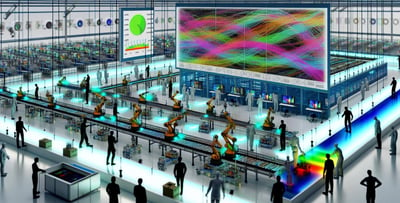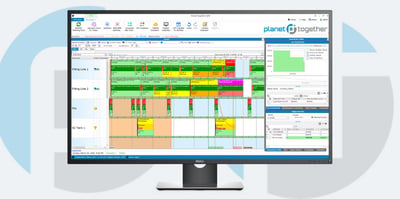Dynamic Job Sequencing Algorithms
Plant managers face an ever-growing challenge: optimizing production processes to meet customer demands while minimizing costs and maximizing efficiency. One of the critical aspects of achieving this goal is job sequencing—the art of arranging manufacturing tasks in the right order to achieve optimal throughput and resource utilization.
In this blog, we will look deep into the world of dynamic job sequencing algorithms and how they can revolutionize your manufacturing facility. Plant managers often find themselves grappling with numerous ERP (Enterprise Resource Planning), SCM (Supply Chain Management), and MES (Manufacturing Execution System) systems. Integrating these systems with advanced job sequencing algorithms can be a game-changer.
We will also discuss integration with PlanetTogether, a renowned production planning and scheduling software, and various other ERP and SCM systems, such as SAP, Oracle, Microsoft, Kinaxis, and Aveva, to streamline operations and achieve unparalleled efficiency.

Understanding Dynamic Job Sequencing Algorithms
Dynamic job sequencing algorithms represent a departure from traditional, static sequencing methods. Instead of using predefined sequences, dynamic algorithms continuously evaluate real-time data to determine the optimal order of tasks on the shop floor. This approach is particularly useful in industries with high demand variability, complex production environments, or frequent changes in priorities.
Key Benefits of Dynamic Job Sequencing Algorithms
Improved Efficiency: These algorithms adapt to changing conditions, ensuring that the most critical jobs are prioritized, leading to better resource utilization and reduced lead times.
Reduced Downtime: By minimizing idle time and equipment changeovers, dynamic sequencing algorithms help reduce downtime, increasing overall equipment effectiveness (OEE).
Enhanced Flexibility: Manufacturers can quickly respond to rush orders, last-minute changes, or unexpected disruptions in production schedules.
Optimized Resource Allocation: Allocate resources effectively by considering constraints, machine capabilities, and operator skills, ultimately leading to cost savings.
Now, let's explore how integrating dynamic job sequencing algorithms with popular ERP, SCM, and MES systems can amplify these benefits.


Integration with PlanetTogether
PlanetTogether is a leading production planning and scheduling software designed to optimize manufacturing operations. When integrated with dynamic job sequencing algorithms, it becomes a powerful tool for plant managers. Here's how it works:
Real-Time Data Exchange
Integration allows for the seamless exchange of real-time data between PlanetTogether and your ERP, SCM, and MES systems. This data includes production orders, machine availability, material availability, and workforce scheduling.
Improved Decision-Making
With up-to-the-minute information, dynamic job sequencing algorithms can make informed decisions about job priorities, sequencing, and resource allocation. This ensures that your plant operates at peak efficiency, even in the face of disruptions.
Streamlined Workflow
Through automation, the integration between PlanetTogether and your systems streamlines workflow execution. Manufacturing tasks are automatically sequenced based on real-time data, eliminating the need for manual intervention and reducing errors.
Enhanced Reporting and Analytics
Advanced reporting and analytics capabilities provide plant managers with insights into performance metrics, such as OEE, lead times, and production costs. This data-driven approach empowers better decision-making and continuous process improvement.

Integration with Other ERP, SCM, and MES Systems
While PlanetTogether is a powerful tool for production planning and scheduling, many industrial manufacturing facilities rely on other ERP, SCM, and MES systems for various functions. The good news is that dynamic job sequencing algorithms can be integrated with these systems as well.
SAP Integration
SAP is a widely-used ERP system known for its robust features in finance, logistics, and supply chain management. Integrating dynamic job sequencing algorithms with SAP allows for seamless coordination between production planning and the broader SAP ecosystem. This integration ensures that production schedules align with overall business objectives and customer demands.
Oracle Integration
Oracle's ERP system is another industry leader in providing end-to-end business solutions. When combined with dynamic job sequencing algorithms, Oracle users can experience improved visibility into production operations, enhanced order fulfillment, and reduced lead times.
Microsoft Dynamics Integration
Microsoft Dynamics offers a suite of ERP and CRM solutions designed to streamline business processes. Integrating dynamic job sequencing algorithms with Microsoft Dynamics allows for greater control over manufacturing operations and resource optimization.
Kinaxis Integration
Kinaxis specializes in supply chain management solutions. Integrating dynamic sequencing algorithms with Kinaxis helps synchronize manufacturing with supply chain operations, ensuring that materials and resources are available when needed.
Aveva Integration
Aveva's MES solutions are designed to improve manufacturing efficiency and quality. By integrating dynamic job sequencing algorithms with Aveva, plant managers can achieve real-time visibility into shop floor activities, reduce bottlenecks, and improve product quality.
Challenges and Considerations
While integrating dynamic job sequencing algorithms with ERP, SCM, and MES systems offers significant advantages, it's essential to consider some challenges:
Data Accuracy and Consistency
To make informed decisions, these algorithms rely on accurate and consistent data. Ensuring data integrity across all integrated systems is crucial to achieving the desired results.
Change Management
Implementing such a transformative change may require adjustments to existing processes and workforce training. Effective change management is essential to ensure a smooth transition.
Scalability
As your manufacturing facility grows, the integrated system should scale seamlessly to accommodate increased production volumes and complexity.
In the competitive world of industrial manufacturing, plant managers must leverage every available tool to optimize production processes. Dynamic job sequencing algorithms, when integrated with ERP, SCM, and MES systems, offer a significant advantage. Whether using PlanetTogether or other systems like SAP, Oracle, Microsoft, Kinaxis, or Aveva, the benefits are clear: improved efficiency, reduced downtime, enhanced flexibility, and optimized resource allocation.
To remain competitive and meet customer demands in a rapidly changing landscape, consider exploring the potential of dynamic job sequencing algorithms and their integration with your existing systems. By doing so, you'll be well on your way to achieving manufacturing excellence and staying ahead of the curve in the industrial manufacturing sector.
Are you ready to take your manufacturing operations to the next level? Contact us today to learn more about how PlanetTogether can help you achieve your goals and drive success in your industry.